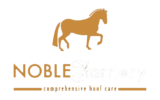The patent-pending Noble Farriery trimming technique is based on the goal of positioning the hoof capsule around the coffin bone in a specific way in order to maintain or increase the vertical depth and concavity of the hoof. This method cultivates growth, creates proper angles, and therefore supports the internal structures of the hoof to aide in proper function. In my daily and therapeutic work, I have found that the lack of vertical depth, combined with a long toe contributes to the breaking down of the internal structures of the capsule. The importance of the physics of the trimming technique is largely overlooked even by farriers and veterinarians.
Establishing a proper balance within the hoof through the trim has helped the most common problems such as cracks, white line disease, pedal osteitis, chronic abscessing, tendon, and ligament issues. To accomplish this I start every trim from the top first and bring the toe and flares back. I shape the perimeter to follow the shape of the hairline. Shortening the toe from the top first helps me not take too much from the bottom because over trimming the bottom of the foot is a huge problem. The goal of the trim should be to maintain a sole thickness roughly equal to that of the dorsal hoof wall.
In most cases when viewed from the top the toe length is roughly one third the length of the entire length of the pastern to the ground. From underneath, one-third of the ground surface of the foot is ahead of the apex of the frog. Ideally, the concavity will slope upwards towards the toe when viewed from the bottom and will also be evenly deep mediolaterally indicating a slight positive coffin angle. I emphasize not trimming too much of the hoof – that if there is nothing to take don’t take anything. All four feet are trimmed before any shoes are put on so that proportions between pairs and between front and back can be checked and adjusted if possible.
I have a concrete set of goals, patterns, priorities, and double-checks to try to ensure the best balance possible at the time. Then shoes and other appliances, most often pads, are used to accomplish whatever I can’t accomplish in the trim, again with its own set of goals, patterns, priorities, and double-checks.
The reason why injury to a hind leg suspensory ligament is common among the English riding disciplines is due to the foot conformation at the time of injury. I have found that it is consistently low in angle, and what farriers call “negative” in angle. A negative angle can be thought of by a layperson similar to walking around on your heels with your toes off the ground. The term refers to the angle of the coffin bone being tipped upward at the toe and down at the heels. Sole or vertical depth being too short from the widest point of the foot back to the end of the heels.
This changes the stride of that leg in such a way that it lands with the toe first. As the horse’s weight moves to the rear of the foot the pastern snaps upward into a high angle and stresses the suspensory ligament.
Treating suspensory injuries begins with proper trimming. By shortening the toe to raise hoof angle, and not trimming anything in the heel region since it is already too low. Raising the hoof angle lowers the pastern angle and changes the landing pattern to be heel first. Almost always the rear of the foot is broken down from bearing proportionally too much weight. I address this with shoes and pads with silicone packing, which acts as an orthotic. The pad and packing add support to the overtaxed structure in the rear of the foot and begin to tip the weight-bearing forward.
As the ligament heals, the rest of the foot slowly grows to have a strong thick sole, strong heels, and a higher angle. The end result is not only a healed ligament but a stronger foot overall. Utilizing this trimming technique as a matter of course at the time of each shoeing cycle will reposition the hoof capsule properly around the coffin bone.

Leave a Reply
You must be logged in to post a comment.